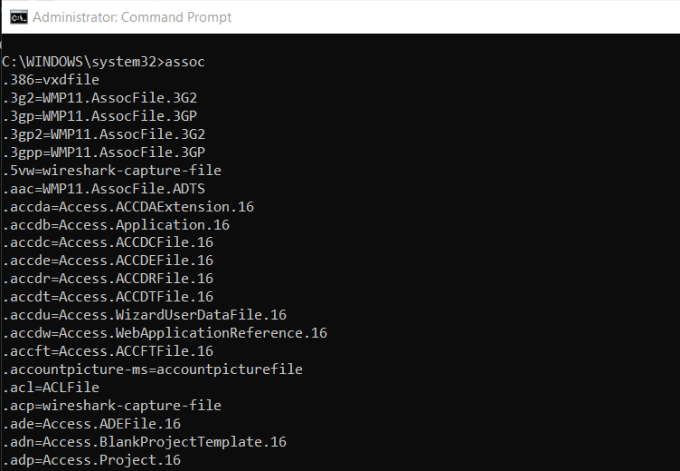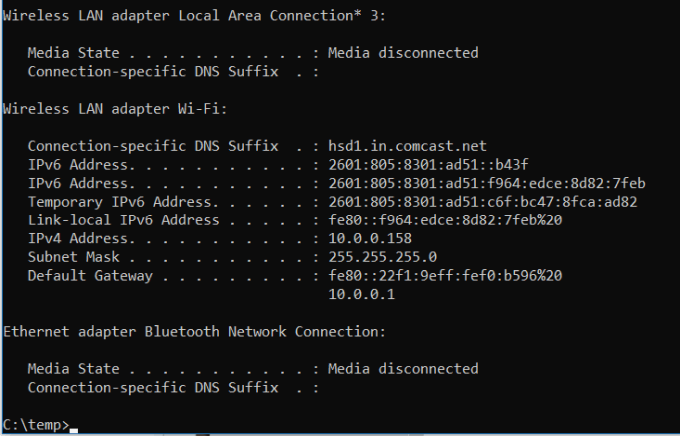So you can have more control over your PC
The Command Prompt has been a core part of the Windows operating system for a long time. Some commands are so helpful that they’re faster and more effective than the graphical interface. Here are 21 of the best CMD commands for gaining more control over your PC.
Also, be sure to check out our YouTube video, where we go over the commands listed in this article:
1. ASSOC: Fix File Associations
The ASSOC command is one of the most powerful tools in the CMD command library.
Your computer associates file extensions with applications. This is how your computer knows to open Adobe when you double-click a PDF file or Microsoft Word when you double-click a DOCX file.

You can view all the file associations your computer knows about by typing ASSOC in the command window. You’ll see the file extension and the program it’s associated with.
You can set the association by typing something like assoc .doc=Word.Document.8.
2. FC: File Compare

It can be challenging to tell the difference between two similar files. The good news is that there’s a CMD command that lets you compare files and see all differences. The FC command performs either an ASCII or a binary file comparison and lists all the differences it finds.
To compare two ASCII files, use a command like the following:
fc /a File1.txt File2.txt
To make a binary comparison of two image files, use a command like this:
fc /b Picture1.jpg Picture2.jpg
3. IPCONFIG: IP Configuration

Network troubleshooting is never simple, but one command that makes it much easier is IPCONFIG.
Using this command in Command Prompt returns detailed information about your current network adapter connection, including:
- Current IP Address
- Subnet Mask
- Default Gateway IP
- Current domain
You can get even more information by typing ipconfig /all.
This information can help you troubleshoot router issues and other connection issues you could be having with your network adapter.
4. NETSTAT: Network Statistics

Concerned that you could have malware running on your computer that’s connecting to internet locations without you knowing about it?
If you run a NETSTAT command in the command prompt, you can get a list of all active TCP connections from your computer.
5. PING: Send Test Packets

An IT Analyst’s best friend is the PING command. Running this command sends test packets over the network to the target system.
You can use the PING command to test whether your computer can access another computer, a server, or even a website. It can help with revealing network disconnections. It also provides transit time for the packets in milliseconds, so it can reveals a bad network connection as well.
6. TRACERT: Trace Route

TRACERT is a fascinating Windows Command to use. If you’re ever curious to see the path your internet traffic takes to get from your browser to a remote system like Google servers, you can use TRACERT to see it. Think of it like an advanced PING command that also shows you each step along the route to the target system.
The command stands for “Trace Route,” which sends packets out to a remote destination (server or website), and provides you with all of the following information:
- The number of hops (intermediate servers) before getting to the destination
- The time it takes to get to each hop
- The IP and sometimes the name of each hop
TRACERT can reveal how the routes of your internet requests change depending on where you’re accessing the web. It also helps troubleshoot a router or switch on a local network that may be problematic.
7. POWERCFG: Power Configuration

Are you frustrated with how quickly your laptop runs out of power? It could be that your power settings are not configured as efficiently as possible. The POWERCFG (power configuration) command can help. Run the command prompt as an administrator and type powercfg – energy to get a full power efficiency report.
The process can take up to about a minute, but when it’s done, you’ll see whether there are any warnings or errors that might help you improve the power efficiency of your system.

View the energy-report.html file to see the details of those errors and warnings.
8. SHUTDOWN: Turn Off a Computer

The SHUTDOWN command lets you shut down a computer and control the behavior of that shutdown. It’s commonly used as a scheduled task or part of an IT batch job after patches have been applied to a computer system.
Typing shutdown /i from the command prompt initiates a shutdown but opens a window that gives you the option to restart or perform a full shutdown. If you don’t want the window to open, you can just issue a shutdown /s command instead.
You can use a long list of other parameters to log off, hibernate, restart, and more. Just type shutdown without any additional parameters to see them all.
9. SYSTEMINFO: System Information

If you need to know your network card brand, processor details, or the exact version of Windows you’re running, the SYSTEMINFO command can help.
This command polls your system for vital information and presents it in a clean, easy-to-read format.
10. SFC: System File Checker

If you’re concerned that a virus or some other software has corrupted your core system files, there’s a Windows command that can scan those files and ensure their integrity.
You must launch the Command Prompt as administrator (right-click and choose Run as Administrator). Typing SFC /SCANNOW checks the integrity of all protected system files. If a problem is found, the files will be repaired with backed-up system files.
You can also use the following switches to alter how the command works:
/VERIFYONLY: Check the integrity but don’t repair the files./SCANFILE: Scan the integrity of specific files and fix them if corrupted./VERIFYFILE: Verify the integrity of particular files but don’t repair them./OFFBOOTDIR: Use this to do repairs on an offline boot directory./OFFWINDIR: Use this to do repairs on an offline Windows directory./OFFLOGFILE: Specify a path to save a log file with scan results.
The scan can take up to 10 or 15 minutes, so give it time.
11. NET USE: Map drives
If you want to map a new drive, you could open File Explorer, right-click on This PC, and go through the Map Network Drive wizard. However, using the NET USE command, you can do the same thing with one command string.
For example, if you have a shared folder on a computer on your network called \\OTHER-COMPUTER\SHARE\, you can map this as your own Z: drive by typing the command:
Net use Z: “\\OTHER-COMPUTER\SHARE” /persistent:yes
The persistent switch tells your computer that you want this drive remapped every time you sign back into your computer.
12. CHKDSK: Check Disk

While the SFC command only checks the integrity of core system files, you can use the CHKDSK command to scan an entire drive. Launch Command Prompt as administrator and use a command like the following:
CHKDSK /f C:
That command runs chkdsk on the C: drive and tells it to fix errors that it finds.
This command checks for things like:
- File fragmentation
- Disk errors
- Bad sectors
The command can fix any disk errors (if possible). When the command is finished, you’ll see the status of the scan and what actions were taken.
13. SCHTASKS: Schedule Tasks
Windows comes with a wizard for creating scheduled tasks. For example, maybe you have a batch file stored on C:\temp that you want to run every day at noon.
You’d have to click through the Scheduled Task wizard to configure this. Or you can type a single SCHTASKS command to set it up. Here’s an example command:
SCHTASKS /Create /SC HOURLY /MO 12 /TR Example /TN c:\temp\File1.bat
The scheduled switch accepts arguments like minute, hourly, daily, and monthly. Then you specify the frequency with the /MO command.
If you typed the command correctly, you’ll see the response, SUCCESS: The scheduled task “Example” has successfully been created.
14. ATTRIB: Change File Attributes
In Windows, you can change file attributes by right-clicking on a file and finding the right property to change. However, instead of hunting around for the file attribute, you can use the ATTRIB command to set the file attributes.
For example, if you type: ATTRIB +R +H C:\temp\File1.bat, it’ll set File1.bat as a hidden, read-only file.
There is no response when it’s successful, so unless you see an error message, the command worked.
Other Windows CMD Commands
As you can see, there are some powerful and useful things you can do with the Windows command prompt, if you know the right commands.
Believe it or not, there are even more commands that will give you the ability to do some things you probably never realized just by typing a simple command.
- BITSADMIN: Initiate upload or download jobs over the network or internet and monitor the current state of those file transfers.
- COLOR: Change the background color of the command prompt window.
- COMP: Compare the contents of any two files to see the differences.
- FIND/FINDSTR: Search for strings inside any ASCII files.
- PROMPT: Change the command prompt from C:\> to something else.
- TITLE: Change the title of the command prompt window.
- REGEDIT: Edit keys in the Windows registry (use with caution).
- ROBOCOPY: A powerful file copy utility built right into Windows.
If you’re interested in learning more, Microsoft offers a full list of all of the Windows CMD commands included in the latest version of Windows.






